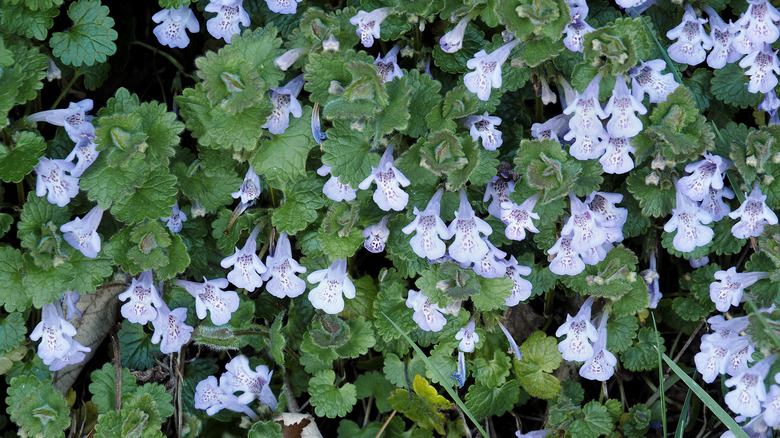Mistakes That Are Making It Harder To Get Rid Of The Creeping Charlie In Your Yard
Don't let the delicate purplish-blue blooms fool you; creeping Charlie (Glechoma hederacea) is a tough perennial spreader that can quickly dominate your yard if you let it. Native to Europe, this pesky weed has been tormenting homeowners as far back as 1672 in New England. Because it can thrive in poor conditions, early settlers brought this plant over to implement it as a shade-loving groundcover in North America. Now, we've realized it's a bit more persistent than we once bargained for, and it may feel like no matter what you do, this plant always finds a way to pop back up.
Allowing more sunshine in your garden and limiting moisture can help get rid of creeping Charlie in your yard, but for many homeowners, making drastic changes like removing trees or adjusting soil drainage isn't practical. If you're using borax or other gardening hacks to try to kill it — along with failing to remove the whole plant when removing by hand – you could be making some huge mistakes. While it may be tempting to let it do its thing and spread across your yard, this invasive species can take over your garden.
Spreading through underground stolons and by seed, creeping Charlie can quickly choke out native grasses and plants. Its tenacious root system makes it challenging to eradicate fully, and even a tiny fragment left behind can lead to a fresh outbreak. Without proactive measures, this invasive weed will continue to spread, creating a larger problem that becomes harder to control over time. If you've tried removing this plant to no avail, there are other solutions to try instead.
Using borax to get rid of creeping Charlie
With the continual rise of social media, gardening hacks have become increasingly popular. One of the methods you may have seen floating around the internet is using borax to eradicate this weed. Finding the least harmful ways to kill weeds in your lawn is better for the environment and is typically a solid approach to consider. Unfortunately, in this case, researchers have concluded that borax isn't as effective as some claim and harms other surrounding plants instead. One issue is that determining the proper amount to use isn't as straightforward as it may seem. Not applying enough in a targeted area means creeping Charlie will continue to thrive, and being too heavy-handed can harm desired species and destroy the soil. Additionally, different pH levels and soil types tend to affect its efficacy, making it even harder to achieve consistent results.
To tackle major outbreaks of creeping Charlie, a potent post-emergence broadleaf herbicide may be necessary. For effective weed control in your lawn, choose a weed killer that contains salt of dicamba or triclopyr, as these compounds will target persistent spreaders like creeping Charlie without harming most lawn grasses. That said, these products aren't recommended for use if there are nearby vegetables or flowers, because it only takes a bit to kill them off along with the weeds. Hand pulling in garden areas is your best bet to remove pesky weeds while keeping your beloved plants safe.
Failing to remove all parts of the plant
Finding the best ways to keep creeping weeds under control without using chemicals isn't an easy task. Removing weeds by hand can be effective for small patches, but don't fall for the weed-pulling myth that it's always the best method. To effectively stop the spread of Glechoma hederacea, it's crucial to remove the entirety of the plant and root system, which can be a physically demanding task when you have a large crop of creeping Charlie. To tackle small areas, wet the ground first to make sure you can easily lift all parts of the root from the ground. Acting fast and persistently pulling weeds can prevent spreaders from taking up larger areas.
Furthermore, if creeping Charlie is taking over your yard, mowing alone isn't enough to manage its aggressive spread. Not only will removing the surface not eradicate the weed, it may instead encourage new growth. To effectively manage creeping Charlie, maintain a mowing height of 2 to 3 inches. Setting your lawnmower too low will weaken your grass rather than the weeds, so the proper height can give your lawn more fighting power. Keep up with all your lawn needs, including routine fertilization, to enhance its strength. A healthy, well-taken-care-of lawn may not be enough to eliminate creeping Charlie, but it can keep it at bay and make it harder for weeds to creep in.


